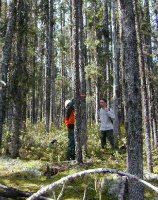Biomass and nutrients calculation

How much biomass is there in the branches, trunks, foliage and bark of a tree or a stand, and what quantity of nutrients does it contain? These calculators make it possible to rapidly obtain these estimates at the tree or stand level for almost any forest stand in Canada. Results can be used to help determine the potential of a stand for the production of traditional and non-traditional forest products, including biomass production for bioenergy from harvest residues or dead trees. Results can also be used to build carbon and nutrient budgets to help evaluate the environmental sustainability of different harvesting methods.

The equations, analysis methodology, and error terms are presented in following scientific papers:
- Lambert, M.-C.; Ung, C.-H.; Raulier, F. 2005. Canadian national tree aboveground biomass equations. Can. J. For. Res. 35:1996-2018.
- Ung, C.-H.; Bernier, P.; Guo, X.-J. 2008. Canadian national biomass equations: new parameter estimates that include British Columbia data. Can. J. For. Res 38:1123-2232.
At the stand scale, equations were developed to calculate biomass and nutrient contents (nitrogen, phosphorus, potassium, calcium, magnesium) for the different tree components (stemwood, foliage, branches and bark) of the 30 most abundant tree species using basal area. Biomass and nutrients can be estimated for a species within a mixed stand. These values can be estimated for generic categories of deciduous or coniferous stands (for a known species that is not on the list or for an unknown species), or for all species. The equations, analysis methodology, and error terms are presented in the following scientific paper:
- Paré, D.; Bernier, Y.; Lafleur, B.; Titus, B.D.; Thiffault, E.; Maynard, D.G.; Guo, X. 2013. Estimating stand-scale biomass, nutrient contents and associated uncertainties for tree species of Canadian forests. Can. J. For. Res.
Data on nutrient concentrations in the four tree components were compiled from the scientific literature for the 30 most abundant tree species and are available in the "Canadian forest tree species nutrient database". Parameter values of stand-level allometric equations can also be downloaded.
Individual Trees ENFOR Database
Canadian Tree Species Nutrient Database
- Canadian Tree Species Nutrient Database (Zip file, 268 Kb)
The file contains:
- Readme.doc - Instructions on using and citing complementary databases
- Nutrient concentration.xls - Canadian Tree Species Nutrient Database
- Nutrient - Summary.csv - Summary of the Canadian Tree Species Nutrient Database
Allometric parameters